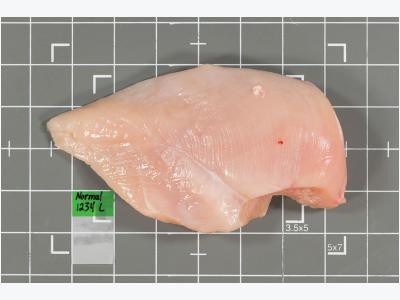Poultry nutritional strategies to reduce woody breast

Normal breast fillets free of the woody breast condition exhibit normal hardness and rigidity upon palpation. | Brian Bowker
Texture quality issues attributed to woody breast in broilers include fibrousness and crunchiness.
With the prominence of high-yielding broilers in the U.S. poultry industry, producers have seen an increase in the number of birds with woody breast. Adisseo and Texas A&M University have partnered to research ways in which woody breast can be reduced through nutritional and management strategies. At IPPE 2017, WATTAgNet discussed these strategies with Rob Shirley, poultry technical services at Adisseo and Christine Alvarado, associate professor of poultry processing and products at Texas A&M.
“Woody breast is defined as breast muscle that is hard to the touch and can cause texture quality issues for consumers,” said Alvarado.
Those texture quality issues include fibrousness and crunchiness, as well as overall unappealing attributes for consumers. This particular issue has become more common with the selection of high-yielding broilers. The trait is categorized on a scale of zero to three, with three being the most severe instances of woody breast.
Nutrition mitigation strategies
“Nutrition is very dynamic, and so is the management of the birds,” said Shirley.
Until the genetics companies have bred this trait out of high-yielding broilers, companies can employ various nutrition and management strategies to reduce woody breast in these birds, according to Shirley.
Strategies Adisseo and Texas A&M studied include:
- Feeding the bird up to 45 days of age
- Supplementing with nutrients that affect vasculature and antioxidant properties of the meat (vitamin C or an increased vitamin premix).
- Slowing down the birds by reducing the amino acid density in the grower phase by about 15 percent
“If you’re feeding a 1.09 digestible lysine diet, you’re going to drop that to approximately .93 percent,” said Shirley.
These strategies have reduced the number of two and three scores to zero and one, moving toward more favorable breast meat for the consumer.
Shirley noted that more research needs to be done to determine what the mechanism is behind how each of the nutrients affects the overall growth, development and protein turnover of the breast meat from day of hatch to market age.
Related news
 USDA rules aim to regulate poultry integrators, growers
USDA rules aim to regulate poultry integrators, growers The Grain Inspection, Packers and Stockyards Administration is proposing regulations on the relationship between integrators and poultry growers
 The pluses and minuses of broiler colonies
The pluses and minuses of broiler colonies Keeping broiler birds in tiered colony housing carries significant health and management benefits as well as new challenges for the grower.
 Responsible use in poultry rather than antibiotic-free
Responsible use in poultry rather than antibiotic-free Dr. Peter Spring, of the Bern University of Applied Sciences, said striving for responsible antibiotic use may be a better strategy than going 100 percent